
by Jennifer
(Arizona, USA)
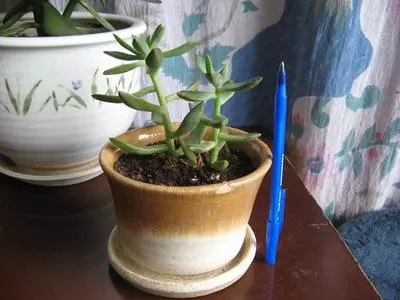




All the tag said was “Rainbow Pack 2.5 inches”.
I really just want to know the name of this little plant (if it has one) and if it’s toxic to pets and how much direct sun it should be getting. I’ve been treating it like my jade plant and so far it’s doing well, but I’ve only had a few days. I searched on the internet literally for hours and I figure it’s a hybrid because I could not find it anywhere on the web.
There are many, many different kinds of succulents that are sold as simply ‘succulent’ or something similar. They’re all the same in that these generally are easy to care for, and forgiving of extremely neglectful treatment – in fact, that’s what they prefer.
In general, it’s not advisable to let pets eat succulents – even if they’re not directly poisonous, they’re probably not going to be well received. I use old bird cages to keep my succulents safe from predation from mice and other creatures, maybe this is a good option for you too.
Your plant is one of the many hybrids (so you’re right in that) but it’s unusual in that it’s a generic hybrid, so a cross between two genera, unlike most hybrids which are crosses between species. This is why it’s called x Pachyveria, which just means that it’s one of the crosses of Pachyphytum and Echeveria. There are many of them, most very similar, but they require similar care – just like what you’re giving it, the same as what you give your Jade plant.
You might find these pages useful:
Succulent Care
How to Grow Echeveria
Miscellaneous Succulent Plants
Happy Succulent Gardening!
Jacki
Comments for Unknown succulent I bought at a Walgreens…
Jul 21, 2013
I think I may have ID
by: Jennifer
I’m the same Jennifer who originally posted this unknown succulent. I think it’s a “Graptosedum ‘Francesco Baldi'”. I’ve also seen it referred to as a “Sedum nussbaumeranium”. But, it’s doing great, is much bigger, and my cat totally leaves it alone.
It’s growing a lot like a sedum, falling over and sprawling/stretching to the light. The bottom leaves shrivel and fall off one by one so that there is a plain stalk at the base and the tops are where the leaves are. The more sun it gets, the lighter green and more brownish it gets, and the rosettes get tighter. New shoots come out of the bottom stalks where the leaves used to be.
Just fascinating to watch the plant grow. I never know what’s next.
Thanks for the update, Jennifer – you’re absolutely right – they constantly change, and are always fascinating!
Jacki
Sep 03, 2014
Rainbow pack
by: Anonymous
These are sold at CVS in Las Vegas, Nevada. They are sold with miniature succulents and cacti. The quality is wonderful and many different types. I haven’t been able to find name of nursery yet but am still looking.
Sep 15, 2014
growth
by: Wanda
I have the hybrid x pachyveria(I think), the first picture that is on your site. I would like to know how fast do they grow? it seems like mine is the same size as I got it about 3 months ago. Do they grow slowly? Will it get bigger? Thanks
Sep 15, 2014
Growth Rate
by: Jacki
Hi Wanda, there are so many different kinds that it’s impossible to say what the growth rate of your particular one will be. It depends on your conditions, the temperature, the light levels; there are so many factors. I would say that you don’t want it to grow too fast – they are not meant to be fast growing as this indicates that they are getting too much water. Sorry I can’t be more precise about it.
Mar 04, 2020
Found it (Google lens helped me)
by: Ermeson
I also bought it, its called Sedum nussbaumerianum.
Leafy green succulent.
by Erin
(Marietta, Oklahoma, USA)
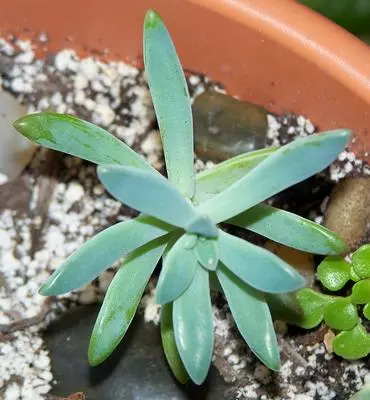
Succulent Cutting Top View
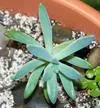
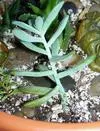
This succulent is light green with leaves spread out all over the stem. This is only one stem that I got as a cutting. When purchasing the plant at the nursery it was labeled “Purple Toes”, but I cannot find anything online with that name (other than Baby Toes, and I know this is not the same plant). The whole plant was growing over the sides of the pot and would likely do well in a hanging pot.
Hi Erin, thanks for the great pictures – that helps immensely! I’m going to make a guess that this is one of the generic hybrids – these are a collection of plants that have been bred by crossing two genus of plants – most hybrids are of two species in the same genus. Confusing, I know. This will most likely be some kind of x Pachyveria, which have Echeveria as one parent, and Pachyphytum as the other. It is a most gorgeous color, I can see why you wanted it!
Find out more about growing Echeveria here; (your plant will most likely be happy with the same kind of care): How to grow Echeveria.
Happy Succulent Growing!
Jacki
Comments for Leafy green succulent.
Jul 31, 2012
Thanks
by: Erin
Thanks for the help! My last one I had you identify seemed to be the same general combo of plants. I knew they looked a lot alike, but weren’t necessarily the same thing. I guess maybe the nursery, or whomever they get their plants from, gave this plant the Purple Toes name.
As you can tell in the pictures, I have this in a pot with several other succulent cuttings (including Sedum Ogon Gold, Portulacaria Afra, Portulacaria Afra Variegata, Aloe Nobilis, Hawarthia Limifolia, and another aloe, possible Aloe Vera). So far all is thriving!
Two fuzzy ones
(Israel)
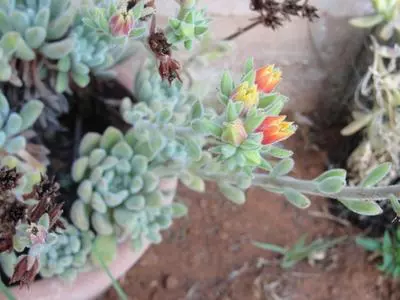
Echeveria setosa

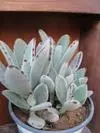
I’ve been researching, but here are two more succulents from my garden in Israel that I’ve yet to identify. One is concentric, the other has individual leaves. Thanks in advance!
The Kalanchoe tomentosum is another of those incredibly popular little plants that at one time or another, we’ve all grown. They’re easy to grow, and their fuzzy leaves with the brown edges or ‘paws’ are so appealing.
Echeveria setosa has the most amazing flowers, unlike many other Echeveria which tend to be pale peach and pink, the fiery red is spectacular.
Both of these succulents are rightfully popular as they’re low maintenance and not fussy as to water (best if you’re not too generous) and responding well to pruning when they get overgrown.
Happy Succulent Growing!
Jacki
heart shaped succulents — they grow out of each other!
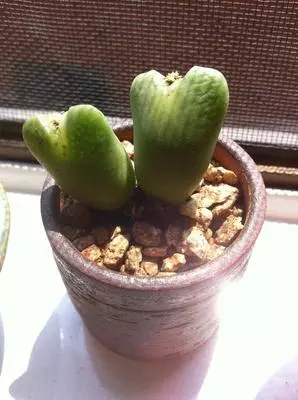
little heart shaped succulents
new one grows out of middle of heart and the old heart outer layer dries away leaving a small little heart
Oh. My. God. That is just the cutest thing! And something I’ve never come across before. I am hoping that someone will see this and know what it is – I want one!
I’ll keep looking around to try and find out what it is.
Thanks for sharing that!
Jacki
Comments for heart shaped succulents — they grow out of each other!
Aug 27, 2012
Conophytums
by: Rita
I believe those are Conophytums.
Succulents found in a Drugstore
by Trina
(Florida)
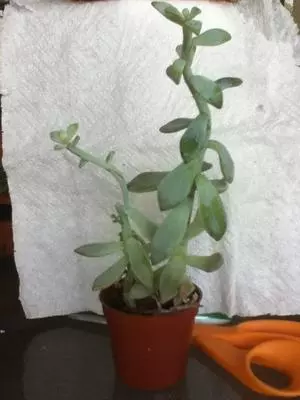
Echeveria species (don’t know which one)
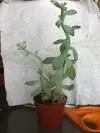
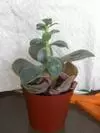
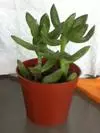
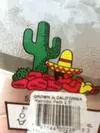
Hi! I found these succulents in CVS here in Florida and I was surprised to see them there. I tried to use the bar code to identify the plants but no bar code reader can identify them. The instructions on care is not readable and neither can I identify the company through its packaging (I attached it as well) except that they were grown in California. Finding them in Florida, I would think they can be raised in this weather – hot and humid. Please help me identify these plants and whether these can be cared for in Florida. Thank you!
Hi Trina, what a great haul! You really cleaned up in the succulents department.
These are all commonly found plants, I’ve labeled them in the caption for each one. Just so you’re aware, these all look very etiolated, or drawn, as if they didn’t get enough light in transit, or when they arrived.
You can see more about how to grow Echeveria and general succulent care here.
Hope that helps,
Jacki
Three different plants
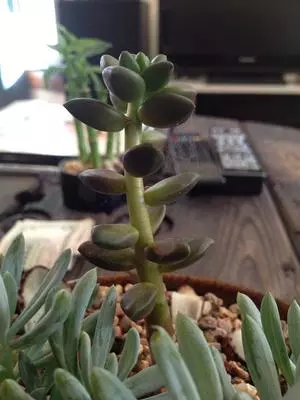
No idea
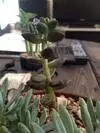
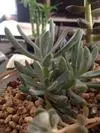
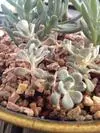

One is a single stalk that is dark green with red on the leaves. The little one is a very pale blue color with teardrop shaped leaves. The last one is a frosty green color with long bulbous leaves.
These are all commonly sold by growers to grocery stores and box stores, most of the time with little in the way of labeling other than ‘succulent’.
I’ve labeled the one that I’m pretty sure of – Sedum spathufolium, which is actually hardy, and will grow outside in many areas, depending on where you are. You can see more here: Sedum spathufolium ‘Capo Blanco’
The blue colored one I think is some kind of Cotyledon, which is a huge genus, but this one shows some of the characteristics of some species.
The tall purple one is a mystery. I’m not sure what that would be – at a wild guess, just based on the way the leaves are spaced would be Pachyphytum.
Hope that gives you a place to start looking anyway.
Happy Succulent Gardening!
Jacki
Comments for Three different plants
Jul 29, 2012
cute little succulents
by: Micki
One of the wonderful things about succulents is the varios sizes they come in. Your little display would be perfect for an office desk – to bring a little “life” to the office world. Have fun!
Jul 22, 2016
late..
by: Janine
hi! i was doing my own research trying to find identification for a few of my succulents when i came across this. Im sure you already found the name for the first picture, but in case you didn’t…its a Echeveria haagai ‘tolimanensis’ They are really beautiful and easy to propagate. I just got one myself that i saved…got myself obsessed with succulents and I’m only 15 smh
Succulent long thin leaves on bulbous body
by Pat
(Virginia)
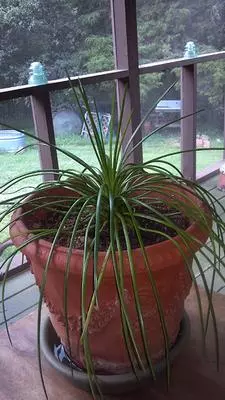
Whole plant
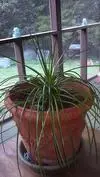
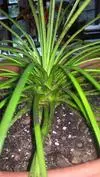
I was given this plant … it has scales which I’m going to try to get rid of (you can see them in the close up shot). It was in a very small pot. Bought at a big box store. The stem is very bulbous (close up shot) and now that it’s been moved into a larger pot, I’m thinking it will expand. Was very root bound. The leaves are long and pointy as you can see. They are succulent. I’ve done a good bit of research and am not finding anything like it.
Hi Pat, boy this one is a weird one alright. At first I thought from you description and a quick glance that it might be the Pony Tail palm, but the way the leaves attach is totally different. Has it bloomed, at all? I wonder if it’s some kind of bromeliad, which is the same family as the Pineapple.
If you can deal with the scale, maybe it will be happy enough to flower and then it should be fairly easy to tell what it is. Sorry I can’t help more than that,
Best of luck with it!
Jacki
Comments for Succulent long thin leaves on bulbous body
Jul 31, 2012
My mystery plant
by: Pat
Thanks, Jacki
I have a ponytail and know this isn’t. The leaves are almost round where they leave the body. And the body is entirely different … not just a bulb going to a stem but a very thick stalk all the way up.
The previous owner said it was sold at Walmart or Lowe’s as a “bonsai” … it had well outgrown the pot and probably (if it gets healthy!) will get too big, but don’t we love it when they’re happy??
Wish me luck on the scales!
Pat
Oh, I do wish you luck – above all, I hope you have a lot of patience and persistence, they are really difficult to get rid of completely – just when you think you’ve finally won, they re-emerge!
Aug 06, 2012
Curious as well
by: Jdlewis
I also have this cute guy and am having difficulty identifying it. It has grown fairly rapidly for a succulent and seems to prefer more shade than some. I am in southeastern New Mexico and the sun can be pretty intense here. I would really like to know his name if you ever discovered it. Happy gardening!!
Aug 06, 2012
My mystery plant
by: Pat
Yes, grows fast. Where did your’s come from, JD? If from a nursery, they may know. Mine came from a big box with no knowledge of what they’re selling.
Aug 08, 2012
Same old story
by: Anonymous
I also got this at a big box store. They are usually good about having accurate identification tags but this one was just an ‘assorted succulent’. Your picture is the only one I’ve been able to come across. I guess it’ll have to remain a mystery for now. I’ll be sure to post if I’m able to find out what we have.
:0)
Sep 11, 2012
Your long thin leafed succulent
by: Anonymous
Hi Pat, I think I have found the name of your succulent as I have the same plant. Mine keeps flowering every year and now i have a bunch of seeds.
Check the name of this plant.
Hesperaloe parviflora
Check this site out as well.
Hesperaloe parviflora
Sep 11, 2012
To annonymous
by: Pat
But are your long leaves very succulent? Mine are oval shaped, almost flat on top, very rounded on the bottom and edges down both sides. And they’re very juicy if broken. And there aren’t any hairy edges. Very smooth. Mine’s never bloomed, but then it’s a indoor plant in the winter here in VA.
Sep 24, 2012
ID
by: Todd
I do believe this is an Agave stricta
Oct 09, 2012
I think I’ve found it!
by: Pat
Came across my plant while following links from a Dave’s Garden newsletter … I think it’s a Dasylirion longissimum, or Mexican Grass Tree.
About two-thirds of the way down this page: here
I think it’s what I have. The leaves look right, including the way they leave the center trunk. The trunk does appear that it will become thick as it gets older. Slow growing is right, though it’s had a glorious summer and MIGHT be free of scales. We can hope so as it’s time to bring it in for the winter here in VA.
See this page on Wikipedia too.
Anyone out there familiar with this Mexican Grass Tree?
Nov 14, 2012
FOUND IT
by: Melinda
I have found the name of this plant!!!! It is a double flowered Agave!!! I just bought this plant at Lowe’s and stumbled on the name of it on the exotic angels web site.
I didn’t find double flowered Agave, but they do have a Twin Flowered Agave; see more here: Agave geminiflora on Exotic Angel Plants Hope that helps.
Jacki
Nov 14, 2012
I stick with my ID
by: Pat
Mine doesn’t have hairy leaves like the twin flowered agave. And the base where the leaves come out is exactly like the pix on the Dave’s Garden site. I do believe I’ve a Mexican Grass Tree. And so far, the scales are gone … it’s inside in the sun since we’re having frosty nights in VA now.
Nov 14, 2012
hairy leaves
by: melinda
I have done some more reading on this plant. The strands that are on some of the picture come with age. If you look at the picture of it on the Exotic Angels page, it shows one with no hairs or strands. I know this is the plant I have because the ID number on the UPC label matched the ID number on the Exotic Angels list. Mine are thin and cylindrical, with sharp, reddish brown points on the end. It also has a base like a Sago Palm, only this one is green and fleshy, where the Sago is brown and more tree like. I am glad you have found out what kind of plant you have!
Jun 24, 2017
I have the exact same 🌵 lol lol lol
by: Tracy from Michigan
I also just inherited the same cactus type plant you are showing in last pic. Mine is in really rough shape, so it will be awhile before I can get it back in good shape, but do please let me know if you’re blooms or you find out anymore info 😂 Thank You!!!
Aug 19, 2017
Agave stricta
by: Marie
Agave stricta
Dec 04, 2017
I couldn’t make out the bulbous body
by: Maurice
I couldn’t make out the bulbous body in your pictures, but my first quess was a ponytail pam, aka elephants foot, ( I have the botan’l name but not within reach right now. Just a wild guess: it looks like a dracaena, but not at all like a bromeliad. Most of them have thick wide leaves which form a reservoir in the center to catch wate, except for pineapples. I’m too busy trying to i.d. my own plants to search this one, but good luck.
Seek and you shall find! I’d be happy to be corrected.HAGD!🐒
Small trailing and bright green bulbous
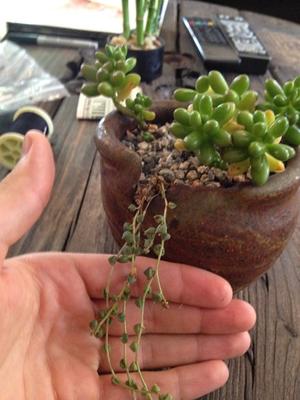
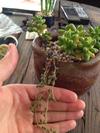
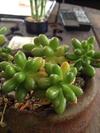
It is not very big. The little buds on it are shaped almost like little hersheys kisses. The other one is bright green. It has short fat little leaves.
The trailing one looks like it could be a really shriveled Senecio rowleyanus, the string of pearls plant. Once they get watered, they plump up over night.
Look closely, and you’ll see a little clear window which is where the light goes in and they can photosynthesize. See more about this plant at the bottom of this page: Miscellaneous Succulent Plants
The chubby guy seems to be some kind of Sedum, but I don’t recognize it. There are many tender ones, which are not frost hardy, so it could be one of those. The closest I can come up with is Sedum rubrotinctum; the colors are wrong for that, but similar shape.
Happy Succulent Growing!
Jacki
Comments for Small trailing and bright green bulbous
Aug 17, 2012
It´s a usual plant here in Brazil
by: Sergio Young
This plant is known (in portuguese) as “dedo de moça” or something like “girl fingers”. Some species have pink extremities and so resemble delicate fingers.
unknown succulent plant with thick leaves
by jeff
(wilmington de)
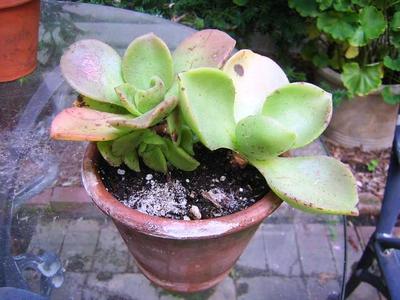




got this in a dish garden from Lowes and replanted it. has thick leaves in rosettes. very firm to the touch. new growth starts out green and then develops reddish tinge. coffee cup shown with plant to give idea of size. what do I have? thanks
Hi Jeff, wow, it looks in rough shape, I’m sure it will be much happier now! This appears to be some kind of Echeveria, of which there are many different species and hybrids, each with their own special appeal. You can see more about them here:
Echeveria List A-L
Echeveria List M-Z
Find out more about how to grow Echeveria here.
Hope that helps whip your plants back into shape!
Jacki
Comments for unknown succulent plant with thick leaves
Oct 31, 2021
Flapjack?
by: Lesley
That kinda looks like a flapjack with the leaves curled inwards. The leaves of mine turned that color as well and I think it was due to too much sunlight. Burning maybe…
Glossy bundle of dark and mid-green densely packed leaves
by Tim
(London, England)
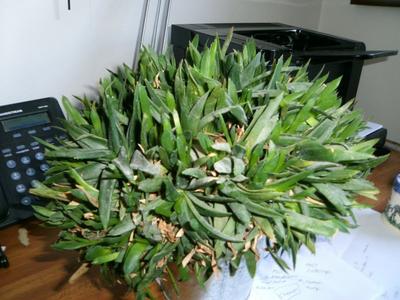




This stands 15cm above the pot. Not sure what else I can say about it, other than that:
- I bought it from Ikea a few years ago but they don’t sell it any more
- I would like to divide and propagate the plant if I can, but need to know how
- It looks a bit sad and dusty and has some dead leaves. What should I do to smarten it up?
Hi Tim, this looks like some kind of Aloe, and a very overgrown one at that. It’s probably so root bound that the roots really have no-where else to go at this point.
There are a couple of options with something this far gone. You can pull it out of the pot, and just start pulling the rosettes apart, which will give you something like 20 plants or more to repot. You can put several in one pot for a bit fuller appearance.
Alternately, and for an ultimately nicer plant, you can unscrew the nicest rosettes just like a lightbulb. These can be stuck into some dry potting mix (use something like a soilless potting soil specifically for cactus) and then allow it to root.
This can take a couple of weeks, and I recommend that whichever way you go, you resist the urge to water. This can cause the broken or damaged parts of the plant to rot, and contrary to what you might think, not watering these types of plants is the best thing.
Happy Succulent Gardening!
Jacki
See more here:
Wanting to learn more about Succulent Plant Propagation?
Comments for Glossy bundle of dark and mid-green densely packed leaves
Oct 27, 2014
I have one
by: Andre D. Manzay
Hey I have one of those plants as well, I thought it was some type of Aloe.
clusters of long, thin grey-green leaves, each one ending like staghorns
by Julie
(Carlisle, Cumbria, UK)
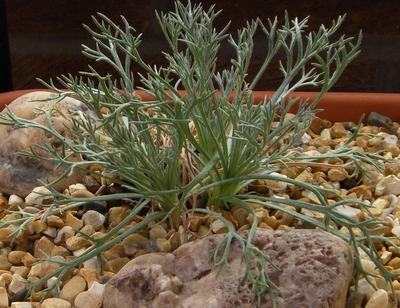
I bought unlabeled succulent in small pot (£0.99). It has a delicate look. Presently each leaf is about 2-1/2 inches long. The leaves at bottom look limp/dying. Looks like plant is comprised of three or four clusters of leaves. Please identify so I can better give it what it needs.
Hi Julie, this one has me stumped, so I’ll publish this and hope that Danielle or another helpful soul will see it and post a reply.
Hang in there!
Jacki
Comments for clusters of long, thin grey-green leaves, each one ending like staghorns
Jun 03, 2013
Identity found – I think
by: Julie
Leucanthemum (Sunshine Peach … new variety I found today; this one photo’d above may be different variety … no evidence of flowers seen yet). An alpine plant with daisy like flowers; height 15 cm (6 in); spread 15 com (6 in).
single stalk, no leaves, clump of berry-like bulbs
by Denise Pope
(Ventura, CA)
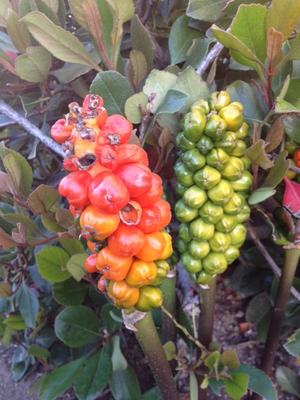
These mystery plants just appeared in my yard. They are about 1 foot tall, have no leaves and a straight thick stalk. At the top of each plant is a tight clump of berry-like objects. The “berries” are squishy and juicy. My boyfriend tasted one and claimed it tasted like a bell pepper. Please help in identifying! Thanks!
Denise Pope
Hi Denise, please don’t let your boyfriend loose on unknown plants! Generally, any berries that are red that you don’t recognize you should never eat.
I thought that this could possibly be ‘baneberry’ or Actaea rubra, which is very poisonous!
Looking more closely at your image, and the fact that it doesn’t display leaves at the same time as the berries makes me unsure of this identification.
These are pretty distinctive berries, so maybe someone has more experience of it and will recognize it.
Don’t eat it, anyway!
Jacki
Comments for single stalk, no leaves, clump of berry-like bulbs
Jul 28, 2012
it’s an arum italicum
by: G.K. Lee
The plant is an arum italicum. The leaves die down and all you see is the cluster. I bought mine from a nursery catalog. The leaves are interesting.
Thanks for that, G. I’ve seen the leaves, which are gorgeous, all veined and quite beautiful. I’ve never seen the spike, quite amazing plant.
Aug 18, 2013
plant suddenly appeared
by: steven georgeAnonymous
I have the same single stalked plant with red berries, which I now guess are poisonous, not that I would be stupid enough to eat anything I dont know. It appeared quite by its self, I have two,both far apart, please tell me exactly what they are, they match the other persons photo, though mine are younger. Are they in fact poisonous?
Did you see the previous comment? The identity was Arum italicum.
You can see more here. As for poisonous, it seems to be more that it’s got oxalic acid crystals can causes dermatitis, but that would go for eating them too; not recommended.
These are also noted as incredibly invasive in some areas. Consider yourself warned.
Jacki
Aug 24, 2014
I just found one exactly like that, outta nowhere!
by: Molly
No leaves. Just a stalk with a knob of red berrylike whatevers on it. Anybody?
Aug 30, 2014
Red berries on straight stalk
by: Maureen East Neuk Scotland
I too have found several of these stalks without leaves showing red berries (some berries are still green) in my rose bed. They were not planted by me. What are they I wonder?
Aug 30, 2014
Arum italicum
by: Jacki
Look through the previous comments for the link to more information on this plant (or Google it!)
Oct 08, 2014
What plant has no foliage and clusters of red berries on top of a fleshy 1′ stem?
by: David
Most likely Arum – Arum maculatum or Arum italicum in particular.
Common names include Cuckoo Pint, Lords and Ladies in the UK, with other common names in other parts of the world.
They do have leaves earlier in the year, which you may not have noticed, but by the time the berries form, the leaves have all died back.
Contact with any part of the plant may cause an allergic reaction in some people, but only the berries are toxic – said to be highly so if ingested, though there is some argument about that.
The berries contain something that makes consuming them like eating needles, so most people never eat enough to be killed, though swelling of the mouth and tongue might mean they asphyxiate.
They’re commonly found in association with trees, and in disturbed soil (disturbed can mean simply cultivated). The only thing that gives me pause is the height – usually, the stalks with the berries clustered around are about 6-8 inches in height. Be good to see a photograph.
There is no evidence that they are allelopathic, though the presence of this plant in quantity could mean deprivation of nutrients and water to your other plants in the area.
weird like finger plant??
by sam
(cleveland ohio)
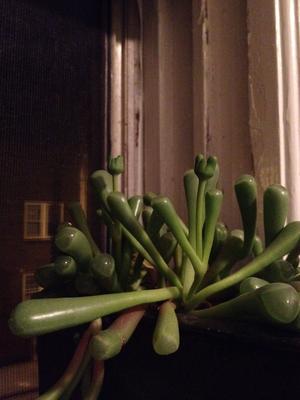
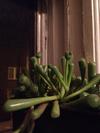
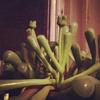
its a smaller plant each “finger” or “minibat” is 2 to 3 inches, and at first it was very clustered together, once it had more room it spread and started growing these weird hand like things.
Hi Sam, what an odd looking little guy! I like it – it’s like something from a cartoon. I think the little darker spots on the ends of the leaves are windows, so that leads me to think that this could be some kind of Conophytum or Opthalmus, which are similar to living stones.
I’ll post this, and hopefully one of my trusty succulent plant collectors will be along to verify or deny my thought.
Hang tough!
Jacki
Comments for weird like finger plant??
Sep 05, 2012
A Possibility
by: Jacki
As I suspected, one of my faithful followers on the Drought Smart Plants Facebook page has suggested a possibility that I didn’t expect; she says; “It looks like Fenestraria aurantiaca (baby toes) It needs more light, it should be more compact and much less leggy.” So, put it somewhere it will get more light, which is the only way to make these kinds of plants more compact. If they have to stretch to get at the light they need it can create this long and uncharacteristic growth.
Oct 20, 2014
Possibly ET
by: Glenn Pallast
Hi I am new here and I know this is an older post, but could this plant possibly be an ET Finger Plant (Crassula portulacea). I thought it might be worth checking out, awesome looking plant by the way.
May 15, 2015
gollum
by: Michelle
This looks very much like a plant I have called Gollum.named such because it is considered a monstrous version of the jade plant.if I’m right,thn it’s supposed to be leggy,but under the right light will grow vigorously
Nov 27, 2017
Baby toes
by: Gabriel
One of it’s nicknames is baby toes which I know how odd that sounds haha but look up baby toes in Google and I’m sure you will find your plant
Succulent cactus-like leaves with red spikes/thorns on them
by Angelo Maniquis
(Bethesda, MD, USA)
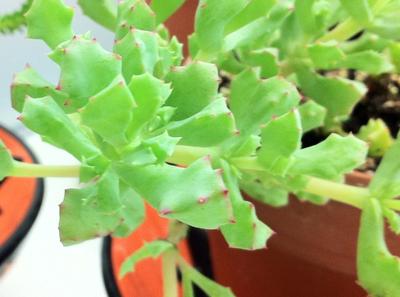


It looks like the stems themselves are succulent.
It reminds me of a cactus but I don’t think it is.
It has succulent leaves similar to cactus, with red spikes at the edges.
I need to know what they are so I can pinpoint their care requirements. It looks like it is not doing ok. Please help.
Hi Angelo, just so you know, all cactus are succulents, but not all succulents are cacti.
This odd looking thing reminds me of some of the Euphorbia – the dead giveaway trait is if it oozes white latex-like sap if the stem or leaf is damaged.
This will narrow it down.
Please be extremely careful if this is the case, as the sap can cause contact dermatitis, as well as blindness if it gets in your eyes.
Other than that, I have never seen this plant, so I can’t tell you what it might be. Wait a bit, and someone might be along who can tell you with more certainty.
Jacki
See this page for more on Euphorbia.
Comments for Succulent cactus-like leaves with red spikes/thorns on them
Aug 24, 2012
Lighting
by: Angelo
Thank you, Jacki. I have not done the sap test because I am afraid I might make its condition worse. My coworker and I went back to the lady that sold this to us and was told that it needs a lot of lighting; but that’s about it. The color is getting light, the stalks turning yellow, but it doesn’t look that bad. So I placed it under lighting and am observing the condition in the next week or so.
Feb 08, 2013
Jun 12, 2017
Ice plant?
by: Marina
Hi Angelo and Jacki,
I just purchased a succulent that looks exactly like the one in Angelo’s pictures. I’ve also been searching to identify it. The Ice plant link that Jacki posted has one photo of the plant then two of its blooms but in the bloom photos the green bits are a completely different looking shape, a totally different looking plant all together. When googling ice plant nothing at all comes up that looks like the ones I and Angelo have/had. I’m having trouble believing this is an ice plant and that that post didn’t just upload a wrong photo. Please let me know if you find anything else on it!
All best,
Marina
Jun 12, 2017
Common Names – bah!
by: Jacki
Marina,
That’s why I try to use botanical names – there are several plants that go by the name Ice Plant! When I was a kid, ice plants were Mesembryanthemum, the kind grown as an annual. Now I’ve seen Delospermum, Lampranthus and others all called Ice Plant.
Jun 12, 2017
Got it!
by: Jill
Oscularia deltoides!
With the little I know, it almost seems that Ice plant refers to the flower type?
Two unidentified plants that I bought at Walgreens
by Michael
(Lincoln, Nebraska, United States)
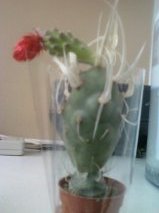
Cactus

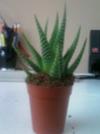
I’m sure these two plants are quite common; one is obviously a cactus, but the other I’m not entirely sure on. My friend seems to think it’s a succulent of some kind. Would someone be able to identify these plants for me? Sorry the photos are sideways.
I fixed your pictures, no worries!
First of all, the cactus. I’m sorry I can’t identify this, as it appears to be wrapped in something (clear film of some kind to protect against the thorns?) which should be taken off immediately. It’s blooming which is probably a good thing, and I’m sure was the reason you bought it. However, just so you know, the blooms are fleeting, and once it’s done, that will be it – until next year, if all goes well, and you provide just the right conditions. See more about Cactus plants here.
The succulent is a Haworthia – one of my all time favorite kinds of tender succulents. See more about them here– this one is most likely Haworthia attenuata, or Haworthia fasciata, both very similar and easy to grow if you follow the care instructions.
Best of luck with your new addiction!
Jacki
You might like these pages too: Succulent Care
Comments for Two unidentified plants that I bought at Walgreens
Sep 24, 2012
CACTUS ID
by: Todd
Difficuly to see through plastic, but looks like Tephrocactus articulatus.
succulent
by Carole Lajoie
(Flagler Beach, Fl. Flagler county)
beautiful long leaves, green no flowers with babies around the entire leaf edges on every leaf. They drop off and start new plants.
I only have 2 pictures to send you. Plant measures right now 17″‘s tall and from tip of the furthest leaf on the left to the tip of the furthest on the right 23″‘s wide.
I hope you can give me a name for this plant so I can research more about it.
Thank you much from CAROLE LAJOIE, IN FLAGLER BEACH, FL. I did everything you ask of me. I tried to resize the photo through Monkey whatever. Then I sent photos to my desktop. The comeback is the same. Photos to large To you have an email address I can go through. This is really important to me. Thank you in advance. Please respond.
Hi Carole, sorry, this system will only accept pictures that are less than 100kb, so you have to edit them down – however, based on your description, there are two possibilities for your plant identification, so check these out first: Kalanchoe delagoensis and Kalanchoe daigremontiana.
Best,
Jacki
Unidentified Succulents
by Trina
([email protected])
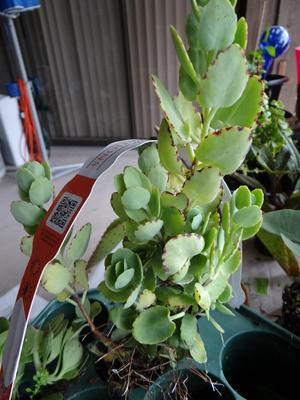
Kalanchoe species (could be rhombopilosa)
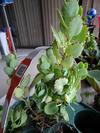



Hello Jacki,
My succulent garden has grown so much because of your help. Your website is the only place I go to whenever I find an intriguing succulent that has no name. I am asking your help again in identifying these succulents I found in Homedepot. They were in the outdoor section of the store in full sun so I hope these will all survive in Florida’s weather conditions. Thank you very much!
Hi Trina, you certainly are getting quite a collection happening! I’ve labeled the pictures that you posted with the names that these most likely are. You can see more about Echeveria Perle von Nurnberg here. Kalanchoe species here and more about Kalanchoe thyrsiflora on this page.
Hope that helps with some information for you. Make sure you scroll through the visitor pages under each page for more.
Jacki
Mystery succulent help please
by Carole
(UK)
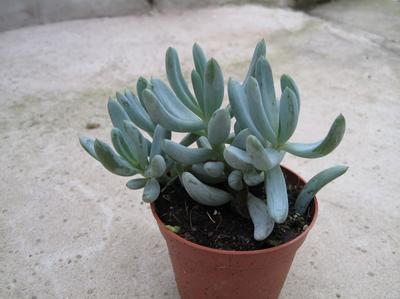
I bought this without a label and the stall holder had no idea what it is. Can you help me name it so I can give it what it needs to survive please?
Fleshy leaves are about 2″ long and it is sending up a little sucker by the edge of the pot
Hi Carole – lucky you – I’ve been wanting one of these for a while now; it’s Senecio serpens, sometimes also called Kleinia repens, which is its old name. It also goes by the common name of Blue Chalk Sticks, which when you look at the plant, is a pretty obvious description.
Easy to care for and grow given the right conditions, this plant will eventually reach about 30cm across and high, but is easily pruned to keep smaller and more compact.
Bright light, either outside on a warm patio or in a south facing window is essential – a grow light in lieu of a window if you don’t have southern exposure and during the winter will stop it from stretching.
Well drained soil, either a cactus mix bought at most garden centers or you can mix up your own with potting soil half and half with small gravel, perlite or pumice whichever you can find, and very light on the fertilizer will keep this little guy happy.
I keep my related Senecio mandraliscae almost completely dry in the winter as it can go dormant if it doesn’t receive any water, and recovers almost instantly when spring arrives.
Happy Succulent Growing!
Jacki
Wanting to learn more about Succulent Plant Propagation?
Comments for Mystery succulent help please
Jul 12, 2012
Thank you!
by: Carole
That is brilliant Jacki, thanks again for the identification and the advice on how to keep it alive and growing.
I would never have found out what it is without your help!
😉
nameless gift
(Israel)
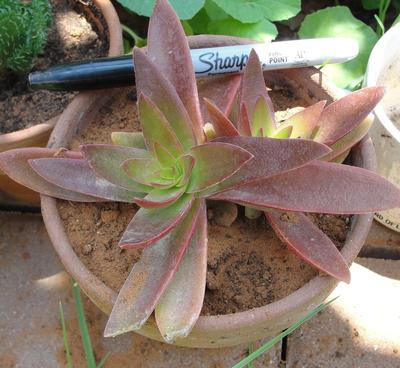


I got this succulent as a gift recently (in one of those tiny plastic pots). I love its color, but can’t figure out what it is. Its leaves are longer than most, and it can take full sun – that’s no small feat, here. Can you help?
Hi Haveda, this looks like an Echeveria, but it’s not one I’m familiar with. I agree with you about the color, that’s fabulous. Now having second thoughts; I am just wondering if that is correct, looking at the arrangement of the leaves – they almost look like they grow opposite each other in pairs, unlike Echeveria which grow in a whorl.
Other possibilities are Crassula, which does the opposite leaf arrangement, or even Cotyledon with a similar growth habit.
Crassula capitella, the Campfire jade on this page looks a lot like it in leaf shape, not so much in color.
Hope that helps get you started, anyway.
Jacki
Need help to identify some succulents!
by Maria Clara
(Recife, Pernambuco, Brazil)
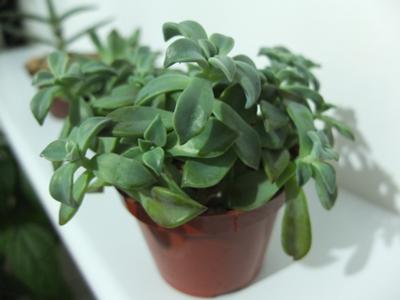
A) This one I have no idea..




Hi, I recently was given four succulents and I’m not sure how to take good care of them, since I don’t know for sure “who” they are.
Below are the pictures!
Thanks 🙂
Hi Maria Clara, you have a great start to a collection there; all of these are quite forgiving of neglect, abandonment or outright abuse, and will thrive in your home or garden as long as they get three important requirements:
Ample water when growing, reduced water in winter or when growth slows, and allowing the soil to dry out considerably before watering again.
Bright light, if indoors, a south or east facing window is perfect, outdoors, afternoon shade is best if you are in a really hot and dry area.
Well drained soil is essential. Depending on where these were grown, they could be potted into really unsuitable soil, such as a peat or manure based potting soil. Although many other greenhouse plants like this type of soil, succulents resent it, and in some cases it can be fatal as there are root rot organisms in soil that holds too much moisture.
So, here goes for identification: A) is some kind of x Graptoveria, Pachyveria or other related hybrid. Sorry, I can’t pin it down any more than that, but see the page on how to grow Echeveria and follow the guidelines there.
B) is indeed Echeveria pulidonis – this one looks like it needs more light. You can see more about it here.
C) is either a Crassula or Cotyledon, I’m not sure which.
D) is a Kalanchoe tomentosa, or the Panda Plant or Chocolate Soldier. You can see more about Panda Plant on Dave’s Garden Website.
For general succulent care this page gives an overview.
Best of luck with your new collection!
Jacki
Comments for Need help to identify some succulents!
Jul 09, 2012
Thanks!
by: Maria Clara
Thanks a lot, Jacki!
You’ve helped a lot. I’ve already moved my Echeveria to a lighter place, and I’ll take good care of those lovely succulents for sure 🙂
what is the name of this particular madagascar?
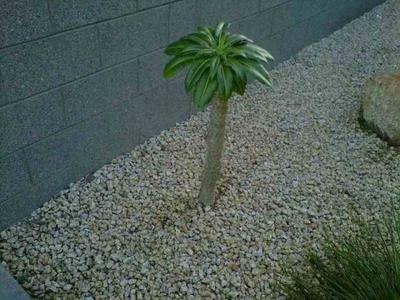
has madagascar trunk but leaves are not spiny thin like most. they are wider,all green and shiny and just grow on top umbrella like. this plant has been this small height for three years. two larger ones exact to this are tremendous and bloomed white flowers.keep being told its a madagascar but cant find one like it.
I’m not 100% clear on what you mean by madagascar?? Do you mean the Madagascar Palm, by chance? This is known as Pachypodium lamerei. The white flowers sound fantastic, I would love to see a picture of those. If you’ve subscribed to see comments from other people on this post, you’ll probably get an answer from one of my other visitors about your plant – be patient!
Jacki
evergreen waxy leaves with single stem and tiny pink flowers
by Jan
(Liverpool)
evergreen waxy leaves with single stem and tiny pink flowers. I think the name has some nobility in the title. Very pretty tiny pink flowers blooming from a single stem. Spreads quickly, attractive leaves, not spikey, round leaves with cut-out edges, provides great ground cover, not sure whether it is a succulent, when I bought it, I was told it was called Duke or Earl (maybe) of something, I can’t remember what he said?
Hi Jan, the only thing that comes to mind is Kenilworth Ivy, which is known as Cymbalaria muralis. Could this be it? I’ve seen this great little plant scrambling over brick walls and down the sides of steps, or even in hanging baskets. It would be great to know if this is your mystery plant.
Happy Gardening!
Jacki
Comments for evergreen waxy leaves with single stem and tiny pink flowers
Sep 07, 2012
kenilworth Ivy
by: Jan
Thank you for suggestion, my plant is very similar in appearance, but the flowers are many in number from a tall single stem forming tiny little flowers, smaller than the Kenilworth Ivy flowers but more of them.
Hi Jan, can you send me a picture? It’s too hard to identify something from a description. I just threw that out there, as it seemed to fit (there is a Kenilworth Castle, isn’t there?)
Sep 08, 2012
I’d like to know too!
by: Lindsay
I wonder if it’s the same one I’m trying to identify… Lindsay’s image
Sep 09, 2012
Kalanchoe?
by: haveda
Lindsay’s plant looks like some kind of Kalanchoe…
Sep 09, 2012
Sedum spectabile
by: Jacki
Lindsay, your plant is one of my favorite stonecrops, Sedum spectabile – there are many different species, but this one is most likely either Sedum ‘Brilliant’ or Sedum ‘Neon’. Hope that helps.
For Jan, if yours isn’t this plant, we’ll need a picture to help identify it – can you post again, or just reply to your original email and attach a pic?
Spindly, blue-green succulent from Home Depot
by Lauren
(IL)
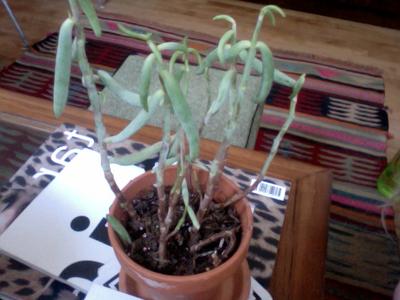


I bought this plant from Home Depot, where it came with a generic tag labeling it a succulent, but it had no other information.
The plant is about 8″ tall and is doing well in bright, indirect sunlight with infrequent waterings. It has blue-green, finger-like leaves that sprout from a woody stem. There are little tufts of almost invisible hairs at the tops of each stem where new leaves form. The leaves near the bottom shrivel rapidly and drop off, but new leaves are continuously forming.
If anyone has any information about this plant, I’d love to find out more. Thanks!
Hi Lauren, I have to give you credit for taking on a challenge, that’s for sure! I’m not 100% sure, but I’m thinking this plant (whatever it is) has at some time been kept in almost complete darkness. I’m pretty sure it shouldn’t look like this, with the drooping leaves and the long spaces between them.
If I was to guess at what this might be, I would say it’s possibly some kind of x Graptoveria. If you want to try and salvage it, I would probably try and propagate some of the leaves, or take a couple of stem cuttings, just to see if the resulting plant looks a bit more recognizable.
I find that once a plant has been let go to this extent, it’s almost impossible to get it to recover it’s former glory; however, propagating it and starting over with a new young plant, then providing the right conditions from the start will give you a perfectly adapted specimen.
Happy Succulent Growing!
Jacki
See more here: Succulent Plant Propagation or buy the Succulent Plant Propagation E-Book.
Looks like a diamond in the center…
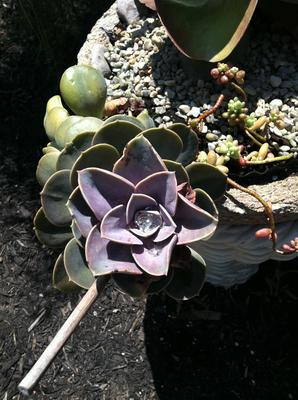
It’s green near the bottom, purple near the center. After it’s been watered the water appears in the center and resembles a diamond. New growth are tiny little buds.
This is most likely some type of Echeveria, which come in all shapes, colors and sizes. They’re very drought tolerant, but can’t survive any frost at all, so depending on where you are these are indoor plants for the winter, and outdoor patio plants during the summer.
For more on how to grow Echeveria see this page.
Happy Echeveria Growing!
Jacki
Mystery succulent
by Miesha Griffin
(Biloxi, Mississippi, USA)
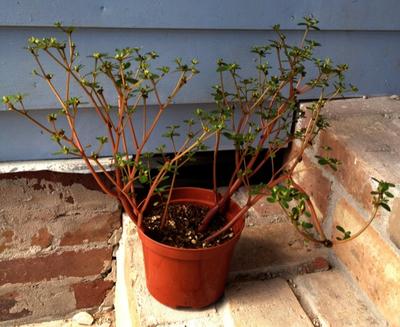

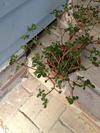
Red branches, small green leaves. Bloomed once (tiny yellow flowers) but only for a day.
Hi Miesha, until you said that it has tiny yellow flowers, I was going to suggest that this might be Portulacaria afra, the Elephants Food, but they have pink flowers in clusters; so, sorry I don’t know what it could be.
Hopefully someone will recognize it soon for you.
Jacki
Comments for Mystery succulent
Aug 08, 2012
Mystery Solved!
by: Miesha Griffin
Thank you Jacki! Your suggestion wasn’t that off the mark. I used your suggestion and Google searched Images. After scrolling down I found something called Purslane. That is what I have. The Wikipedia article gave it the scientific name “Portulaca oleracea” and I learned a lot of useful information. Come to find out Purslane contains more Omega-3 fatty acid than any other leafy plant. Thanks again for leading me in the right direction.
Phil the little slow growing green guy.
by Justin
(St. Paul Minnesota)
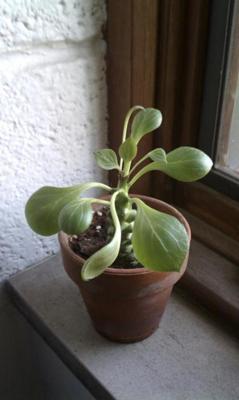
This plant gets leaves in the spring/summer but loses most of them over winter. It has not flowered but has more leaves now than ever. The height of the main body is 2-3 inches. The shape is like a Christmas tree with little spikes sticking out where the leaves used to be.
Hi Justin, I’m not sure what this plant is, unfortunately. I can tell you that it probably would be happier, and not lose its leaves if it gets more light over the winter. The cupping of the leaves indicates that it’s needing more light too.
I recommend a grow light, used with a timer so the plant gets 12 hours of light, all year round.
Most succulent house plants originate near to the equator, where they get warm temperatures all year, and a steady twelve hours of daylight. Even a bright window in northern climates just doesn’t give them the same kind of growing conditions.
Hope that helps with your little guy.
Jacki
See more here: Grow Lights
Comments for Phil the little slow growing green guy.
Sep 24, 2012
Caudiciform ID
by: Todd
This is a Monadenium richtei, and it needs more light.
Found a 2ft tall succulent with drooping green spiked leaved
by Michael N
(San Francisco, CA)
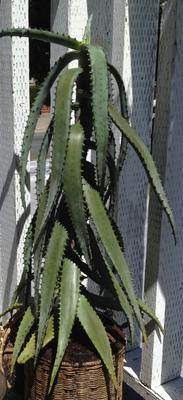
Someone threw this out on the street! It looked like it had only been there for a few hours, still in good shape, but I knew I had to save it.
Can you tell me what this plant is?
Hi Michael, this looks like some kind of Aloe, but honestly, it’s not supposed to look like this, so it’s no surprise that they kicked it to the curb. It appears that it wasn’t getting enough light – these plants require really bright light to look their best and keep their leaves upright.
If you’re thinking you might want to try and resurrect it, here’s what I suggest: Get the mindset that you have to be cruel to be kind, and unscrew the top of the stem, just like unscrewing a light bulb. Make sure you get at least four leaves, and then let it dry out considerably. If you look closely, you’ll see white or pale yellow nodes, which are actually adventitious roots.
After a couple of days, you can plant the top part in some dry potting soil, and in a few days to weeks, start watering it. Don’t be too kind to it, or you’ll kill it with kindness.
Hope this helps with your project,
Jacki
See these pages for more:
was once beautiful
by Bianca
(Valencia, Ca, USA)
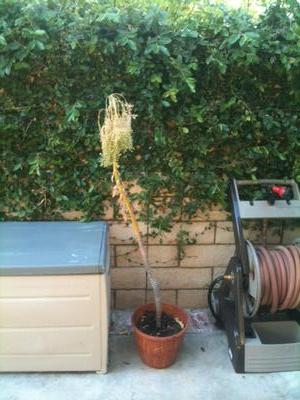
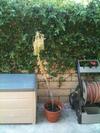
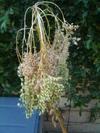
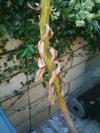
Sorry- I have tried twice to upload the pics.
I bought this succulent at a farmer’s market in a town where I no longer live. It was small and beautiful when I got her. She stood on her one limb, petals(?) like a shining sun. She was happy for about 8 months until a strong wind tipped her over, broke her pot and was lost under the debris from the wind.
Upon finding her, she had curled up like a clam. I packed her in our move and repotted her. She opened up and took off! She must have grown 3 feet in just a few months!! It was remarkable!!! Then, she started to flower…and then start to look a little haggard- we moved her to the other side of our patio- still, full sun, same pot, but she fell over due to the top-heavyness. Since then she has been looking sicklier and sicklier by the day and breaks my heart.
I can’t plant her in the ground because our yard gets so much water. I was told to cut off her flower and some of her stem and most of her stem, but have been too scared too. We actually cut off a lot of her blooms because the owner of a nursery said that they may be sucking the life out of the plant…
I thought it might be my husband- watering her too much…but he says he doesn’t so now I’m left wondering if she has reached her end?? I’ve had her for about a year and a half. She stayed around the same size until I repotted her.
I cannot locate her anywhere. Any suggestions??
She looks very different now than when I first had her. She had long petals about 6″.
Hi Bianca, unfortunately, what you have now is the senesced flower stalk of an Aeonium. These are monocarpic, which means that they die after blooming. In many cases they have produced pups close to the stem at soil level to take up the slack from the flowering stalk.
I’m sorry, but this one is done, dead, over and your husband is off the hook – the plant would have died no matter what care it had. Not to worry, where you live there will be the opportunity to find more, as the conditions there are perfect for these heat loving succulents.
Find out more about these fascinating plants here: Aeonium.
rescued plant, maybe a sarcocornia or rhipsalis?
(Israel)
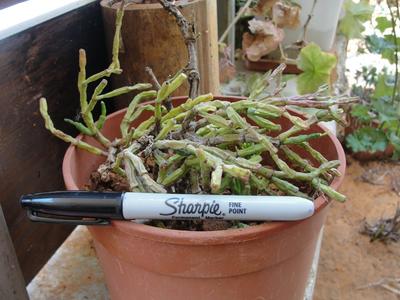



I rescued this one from a heap of trimmings – it was probably there because when I removed it from the original pot, the roots were teeming with ants. It seems to be making a comeback; it likes moderate watering. The growth at the base is new since repotting. But I haven’t been able to make much headway with the ID, so if you know, please do tell!
I think you’re close on the Sarcocornia. I found an image on Dave’s Garden Website that does look similar – maybe compare it to your plant and see. As yours still looks like it needs some tender loving care to get it’s youthful looks back, it’s hard to tell.
Glad you could rescue it!
Jacki
Comments for rescued plant, maybe a sarcocornia or rhipsalis?
Aug 17, 2012
got it!
by: haveda
evidently, it’s a Hatiora salicornioides (or something close).
Multiple Echeveria (?) a Gift from California
(Lakeland, FL)
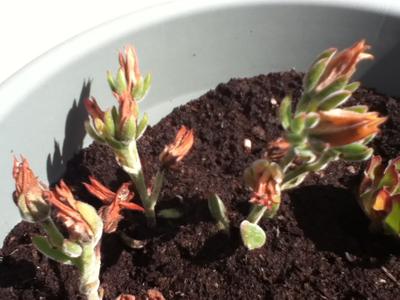
1




I believe these plants are echeveria as I have been trying to research all over for their names to better take care of them.
I got them from California and they were from cuttings from my Aunt’s garden. They were so pretty and I really, really want them in my garden too. I was so glad to learn from my relative that I simply need to stick them to the ground as soon as I arrive from my flight to Florida. But after careful thinking, I really need to do careful research on the plants but do not have any knowledge on succulents and need help on identifying, transplanting from cuttings, care and maintenance especially with the weather in Florida. Any help would be much appreciated.
It’s so nice to see someone who isn’t afraid to jump in feet first!
Okay, starting at the top: 1) This is definitely some kind of Echeveria, however, they normally don’t root from the stems of the flowers. You can take the leaves off, and that part will root, believe it or not. I can’t see it well enough to tell you exactly which one, but I’m leaning towards Echeveria setosa or one of the hybrids of that, such as Echeveria set-oliver.
The second image is some kind of Crassula, which is also known as a noxious weed in some areas, as it reseeds itself prolifically. Sorry, again, don’t know the exact species.
Numbers 3 and 4 are plants voted most likely to be mistaken for Echeveria; in fact, they’re both Aeonium, a completely different genus. Although they are distantly related, being in the Crassulaceae, they require much different care. See more about them here: Aeonium.
For lots more information on succulent care and succulent plant propagation see these pages to get started.
Welcome to my obsession!
Jacki
Wanting to learn more about Succulent Plant Propagation?
dads mystery hourglass shaped pods
by Krisy Ferrette
(Cleveland, Ohio USA)
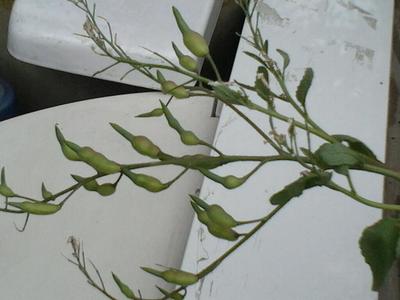
My dad found this growing on my grandmothers grave, brought it home and planted it in a pot. Now that it has grown, we cannot find anyone who can identify it!
I’ve searched the internet and have found NOTHING!
It is about 3ft tall now, it’s all green, and it has these 3inch long kind of hourglass shaped pods growing on them. They almost look like deformed pea pods (hourglass is the only word I can think of to describe them)..please help us identify what grandma is growing for us!
Thank you so much,
Krisy and John Ferrette
Hi Krisy and John, without seeing more the plant and how it grows, I’m going to take a leap and suggest that this is some kind of mustard weed. Sorry to say, Granma is probably laughing her head off right now!
As these look like seed pods, why not take the seed and try to grow it? Then you can maybe identify it from the plant as it flowers.
Best of luck with the mystery!
Jacki
Comments for dads mystery hourglass shaped pods
Jul 26, 2012
guess the joke is on us…lol
by: Krisy
Ha-ha! Thank you so much for responding. Ive posted it on other sites and all I get are pointless emails trying to get me to buy plants! lol I told Dad awesome looking pods that he thought were something special were actually a pesky weed! He just laughed and said, “your grandmother would play a prank like this”, lol.
But, he is going to snip off some of the pods and plant the seeds, he says why not do it, since we’ve already put this much effort into it we might as well go further and see if we can get something to grow out of this whole ordeal. Its totally not a waste of time to me cuz I think it will be interesting to see what comes of these “mystery pods”, lol.
Once again, thank you so much for your input, this is a great and beautiful website. I will certainly recommend it to my fellow plant lovers!
Thanks Again: Krisy and John
Thank you for the kind comments! I hope you have some success with your efforts to figure out what exactly this plant is – best of luck!
Jacki
Sep 24, 2012
Questions
by: Todd
Does it get pinkish or whitish 4 petalled flowers? Raphanus sativas (podding radish) or some relative? If you have the courage to taste it, if this is what it is, it will taste like a radish.
Mar 23, 2013
Your Weed Pods…
by: Pete
Your pods belong to a wild radish.
May 04, 2016
Radish possibly
by: Amy
We grow radish that go to seed and you can eat the pods … add them to salads … real peppery. This looks like them. So I agree, wild radish!


